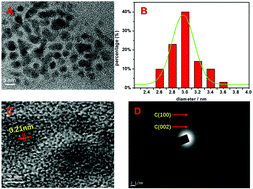2D MnO2 nanosheets generated signal transduction with 0D carbon quantum dots: synthesis strategy, dual-mode behavior and glucose detection†
Abstract
A natural resource such as peony flower has been employed for the first time as a new carbon precursor to prepare green-emitting carbon nanodots (CDs). The emission peak is situated at 523 nm and the excitation wavelength can be extended to the visible light range (452 nm). Due to the formation of CD–MnO2 nanocomposites, the emission intensity of CDs is sharply reduced as a consequence of Förster resonance energy transfer (FRET). Moreover, glucose can be recognized due to the enzymatic conversion of glucose by glucose oxidase to generate H2O2. The MnO2 nanosheets are reduced to form Mn(II) ions, and the fluorescence of CDs can be recovered. The fluorescence intensity has been improved linearly based on the increasing concentration of glucose (0.5–250 μM) with a detection limit as low as 0.18 μM. This strategy gives a new selection of eco-friendly precursors in carbon nanomaterials and such a consecutive recognition process provides valuable insights for bio-analysis.



 Please wait while we load your content...
Please wait while we load your content...